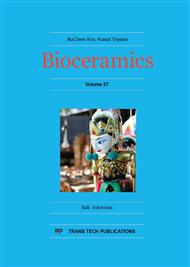[1]
K. Fukushima, D. Tabuani, M. Arena, M. Gennari, G. Camino, Effect of clay type and loading on thermal, mechanical properties and biodegradation of poly(lactic acid) nanocomposites, React Funct Polym. 73 (2013) 540-549.
DOI: 10.1016/j.reactfunctpolym.2013.01.003
Google Scholar
[2]
H. Chen, J. Chen, J. Chen, J. Yang, T. Huang, N. Zhang, Y. Wang, Effect of organic montmorillonite on cold crystallization and hydrolytic degradation of poly(L-lactide), Polym Degrad Stab. 97 (2012) 2273-2283.
DOI: 10.1016/j.polymdegradstab.2012.07.037
Google Scholar
[3]
K. Chrissafis, E. Pavlidou, K. M. Paraskevopoulos, T. Beslikas, N. Nianias, D. Bikiaris, Enhancing mechanical and thermal properties of PLLA ligaments with fumed silica nanoparticles and montmorillonite, J Therm Anal Calorim. 105 (2011) 313-323.
DOI: 10.1007/s10973-010-1168-z
Google Scholar
[4]
E. Picard, E. Espuche, R. Fulchiron, Effect of an organo-modified montmorillonite on PLA crystallization and gas barrier properties, Appl Clay Sci. 53 (2011) 58-65.
DOI: 10.1016/j.clay.2011.04.023
Google Scholar
[5]
K. Nakanishi, S. Yamagata, T. Akasaka, S. Abe, Y. Yoshida, J. Iida, Preparation of a poly(lactic acid)/montmorillonite nanocomposite, Key Eng Mat. 631 (2015) 151-155.
DOI: 10.4028/www.scientific.net/kem.631.151
Google Scholar
[6]
K. Nakanishi, S. yamagata, J. Iida, Characterization of poly(L-lactic acid)/organically modified montmorilonite nanocomposites synthesized by a solution intercalation method, Hokkaido Journal of Dental Science (accepted).
Google Scholar
[7]
J. Houtman, S. Maisanaba, M. Puerto, D. Gutiérrez-Praena, M. Jordá, S. Aucejo, A. Jos, Toxicity assessment of organomodified clays used in food contact materials on human target cell lines, Appl Clay Sci. 90 (2014) 150-158.
DOI: 10.1016/j.clay.2014.01.009
Google Scholar
[8]
S. Maisanaba, D. Gutiérrez-Praena, S. Pichardo, F. Javier Moreno, M. Jordá, A. M. Cameán, S. Aucejo, Á. Jos, Toxic effects of a modified montmorillonite clay on the human intestinal cell line Caco-2, J. Appl. Toxicol. 34 (2014) 714-725.
DOI: 10.1002/jat.2945
Google Scholar
[9]
A. Kumar Sharma, B. Schmidt, H. Frandsen, N. Raun Jacobsen, E. Husfeldt Larsen, M. Binderup, Genotoxicity of unmodified and organo-modified montmorillonite, Mutat Res 700 (2010) 18-25.
DOI: 10.1016/j.mrgentox.2010.04.021
Google Scholar
[10]
Z. Liu, X. Dong, L. Song, H. Zhang, L. Liu, D. Zhu, C. Song, X. Leng, Carboxylation of multwalled carbon nanotube enhanced its biocompatibility with L02 cells through decreased activation of mitochondrial apoptotic pathway, J Biomed Mater Res A. 102A (2014).
DOI: 10.1002/jbm.a.34729
Google Scholar
[11]
S. Abe, N. Iwadera, T. Narushima, Y. Uchida, M. Uo, T. Akasaka, Y. Yawaka, F. Watari, T. Ynezawa, Comparison of biodistribution and biocompatibility of gelatin-coated copper nanoparticles and naked copper oxide nanoparticles, e-J Surf Sci Nanotech. 10 (2012).
DOI: 10.1380/ejssnt.2012.33
Google Scholar
[12]
L. Yang, L. Li, Q. Tu, L. Ren, Y. Zhang, X. Wang, Z. Zhang, W. Liu, L. Xin, J. Wang, Photocatalyzed surface modification of poly(dimethylsiloxane) with polysaccharides and assay of their protein adsorption and cytocompatibility, Anal Chem. 82 (2010).
DOI: 10.1021/ac100544x
Google Scholar
[13]
S. Tsuchiya, S. Abe, T. Kiba, A. Murayama, Y. Yoshida, J. Iida, Size, Morphology and Surface Property Effects of Ceramics Nanoparticles on their biocompatibility, submitted to Journal of Nanoscience Nanotechnology, (2015).
Google Scholar
[14]
M. Mutoh, S. Abe, K. Nakayama, K. Nakanishi, Y. Yoshida J. Iida, T. Takada, Preparation of surface-modified fullerene C60 nanoclusters for bioapplications, submitted to Nano Convergence, (2015).
Google Scholar


